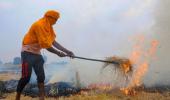Pollution levels in Delhi dipped slightly on Friday with favourable wind speed helping in the dispersion of pollutants even as the contribution of stubble burning to the city's PM2.5 concentration rose to 18 per
cent, according to government agencies.

With Delhi-NCR bracing for months of poor air quality, experts have warned that high levels of air pollution can aggravate the COVID-19 situation.
The national capital on Friday recorded a 24-hour average air quality index of 239. On Thursday, it was 315, the worst since February 12 when the AQI was 320.
An AQI between zero and 50 is considered 'good', 51 and 100 'satisfactory', 101 and 200 'moderate', 201 and 300 'poor', 301 and 400 'very poor', and 401 and 500 'severe'.
The Central Pollution Control Board said that meteorological conditions in Delhi have been "extremely unfavourable" for dispersion of pollutants since this September as compared to last year.
PM 10 concentration between September 1 and October 14 this year has been more as compared to the corresponding period last year, said a CPCB official.
CPCB Member Secretary Prashant Gargava hoped that with less area under non-basmati paddy cultivation in states neighbouring Delhi, the number of stubble burning incidents is likely to be fewer this time compared to last year.
Non-basmati paddy straw is considered useless as fodder because of its high silica content and so farmers burn it.
Gargava also said stubble burning peak might not coincide with the peak of adverse meteorological conditions this year due to early harvesting of paddy.
NASA's satellite imagery showed a large cluster of farm fires near Amritsar, Patiala, Tarn Taran, and Firozpur in Punjab, and Ambala and Rajpura in Haryana.
But, a senior scientist at India Meteorological Department said the dip in pollution levels was likely because of an improvement in the wind speed up to 10 kilometres per hour.
The ministry of earth sciences' Air Quality Early Warning System for Delhi said wind direction on Friday was northwesterly, favourable for the transport of pollutants from farm fires.

According to the System of Air Quality and Weather Forecasting And Research, the contribution of farm fires to Delhi's PM2.5 concentration rose from around six per cent on Thursday to 18 per cent on Friday. It was only around one per cent on Wednesday and around 3 per cent on Tuesday, Monday and Sunday.
With a marginal improvement expected in wind speed by Saturday, air quality is likely to dip further to the lower end of the 'poor' category by Sunday, it said.
The farm fire count was 583 on Friday and the wind direction was favourable for the transport of pollutants. The contribution of farm fires to Delhi's PM2.5 concentration was around 18 per cent, SAFAR
said.
PM 10 levels in Delhi-NCR were 242 micrograms per cubic meter (g/m3) at 6 pm.
PM10 is particulate matter with a diameter of 10 micrometres and is inhalable into the lungs. These particles include dust, pollen and mould spores. PM10 levels below 100 g/m3 are considered safe in India.
The level of PM2.5 -- finer particles which can even enter the bloodstream -- was 109 g/m3, down from 151 g/m3 on Thursday evening. PM2.5 levels up to 60 g/m3 are considered safe.
According to the CPCB, the average ventilation index has been 1,334 metre square per second in September and October this year as compared to 1,850 metre square per second during the corresponding period last year.
Ventilation index is the speed at which pollutants can get dispersed. A ventilation index lower than 6,000 sqm/second, with average wind speed less than 10 kmph, is unfavourable for dispersal of pollutants.
Earlier in the day, Delhi Environment Minister Gopal Rai issued directions for the imposition of Rs 1 crore fine on North Delhi Municipal Corporation for not taking action against garbage burning in Kirari assembly constituency area in northwest Delhi.
Rai also directed the departments concerned to prepare a ground report for the implementation of the "Red light on, gaadi off" campaign to curb vehicular pollution.
Severe air pollution in Delhi is a year-round problem, which can be attributed to unfavourable meteorological conditions, farm fires in neighbouring regions and local sources of pollution.
According to an analysis by the Council on Energy, Environment and Water, a Delhi-based think tank, transportation contribute the most -- 18 to 39 per cent -- to Delhi's air pollution.
Road dust is the second-largest source of air pollution in the city (18 to 38 per cent), followed by industries (2 to 29 per cent), thermal power plants (3 to 11 per cent) and construction (8 per cent).










